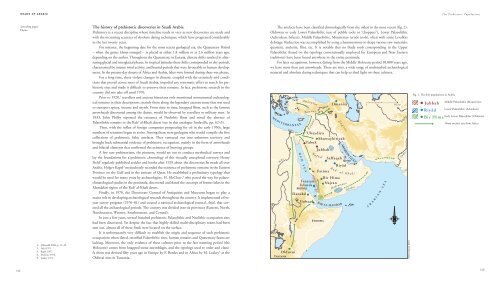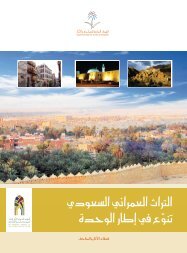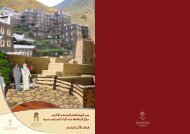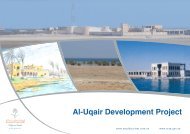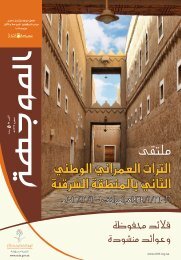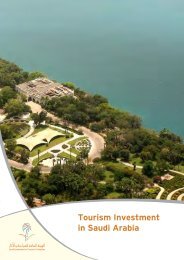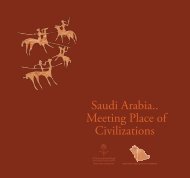Roads of Arabia
Roads of Arabia
Roads of Arabia
Create successful ePaper yourself
Turn your PDF publications into a flip-book with our unique Google optimized e-Paper software.
09 Arabie US p136-157_CM_BAT.qxd 23/06/10 21:32 Page 142<br />
Tabuk<br />
Shuwayhitiyah<br />
ROADS OF ARABIA<br />
(preceding pages)<br />
Dunes<br />
1. Alsharekh 2006, p. 12–39.<br />
2. Field 1971.<br />
3. Kapel 1967.<br />
4. McClure 1976.<br />
5. Leakey 1971.<br />
The history <strong>of</strong> prehistoric discoveries in Saudi <strong>Arabia</strong><br />
w. Fatima<br />
Prehistory is a recent discipline whose timeline tends to vary as new discoveries are made and<br />
with the increasing accuracy <strong>of</strong> absolute dating techniques, which have progressed considerably<br />
Bir Hima<br />
Farasan<br />
in the last twenty years.<br />
Najran<br />
Islands<br />
For instance, the beginning date for the most recent geological era, ERITREA the Quaternary Period<br />
– when the genus Homo emerged – is placed at either 1.8 million or at 2.6 million years ago,<br />
Danakil<br />
depending on the author. Throughout the Quaternary, in Eurasia, climate shifts resulted in alternating<br />
glacial and interglacial phases. In tropical latitudes these shifts corresponded Gobaad to dry periods,<br />
characterized by intense wind activity, and humid periods that were favourable to human development.<br />
In the present-day deserts <strong>of</strong> Africa and <strong>Arabia</strong>, lakes were formed during these wet phases.<br />
For a long time, these violent changes in climate, coupled with the extremely arid conditions<br />
that prevail across most <strong>of</strong> Saudi <strong>Arabia</strong>, impeded any systematic effort to search for prehistoric<br />
sites and made it difficult to preserve their remains. In fact, prehistoric research in the<br />
ETHIOPIA<br />
country did not take <strong>of</strong>f until 1970.<br />
Prior to 1920, 1 travellers and ancient historians only mentioned monumental archaeological<br />
remains in their descriptions, mainly those along the legendary caravan route that was used<br />
to transport spices, incense and myrrh. From time to time, knapped flints, such as the famous<br />
arrowheads discovered among the dunes, would be observed by travellers or military men. In<br />
1933, John Philby reported the existence <strong>of</strong> Neolithic flints and noted the absence <strong>of</strong><br />
Palaeolithic remains in the Rub’ al-Khali desert (see in this Olduvai catalogue Sanlaville, pp. 62–3).<br />
Then, with the influx <strong>of</strong> foreign companies prospecting TANZANIA for oil in the early 1950s, large<br />
numbers <strong>of</strong> scientists began to arrive. Among them were geologists who would compile the first<br />
collections <strong>of</strong> prehistoric lithic artefacts. They ventured out into unknown territory and<br />
brought back substantial evidence <strong>of</strong> prehistoric occupation, mainly in the form <strong>of</strong> arrowheads<br />
and bifacial elements that confirmed the existence <strong>of</strong> hunting groups.<br />
A few rare prehistorians, the pioneers, would set out to conduct methodical surveys and<br />
lay the foundations for a prehistoric chronology <strong>of</strong> this virtually unexplored territory. Henry<br />
Field 2 regularly published articles and books after 1929 about the discoveries he made all over<br />
<strong>Arabia</strong>. Holger Kapel 3 meticulously recorded the existence <strong>of</strong> prehistoric remains in the Eastern<br />
Province on the Gulf and in the emirate <strong>of</strong> Qatar. He established a preliminary typology that<br />
would be used for many years by archaeologists. H. McClure, 4 who paved the way for palaeoclimatological<br />
studies in the peninsula, discovered and dated the outcrops <strong>of</strong> former lakes in the<br />
Mundafan region <strong>of</strong> the Rub’ al-Khali desert.<br />
Finally, in 1970, the Directorate General <strong>of</strong> Antiquities and Museums began to play a<br />
major role in developing archaeological research throughout the country. It implemented a fiveyear<br />
survey program (1976–81) and created a national archaeological journal, Atlal, that covered<br />
all the archaeological periods. The country was divided into six provinces (Eastern, North,<br />
Northeastern, Western, Southwestern, and Central).<br />
In just a few years, several hundred prehistoric Palaeolithic and Neolithic occupation sites<br />
had been discovered. Yet despite the fact that highly skilled multi-disciplinary teams had been<br />
sent out, almost all <strong>of</strong> these finds were located on the surface.<br />
It is unfortunately very difficult to establish the origin and sequence <strong>of</strong> such prehistoric<br />
occupations when dated, stratified Palaeolithic sites, human remains and Quaternary fauna are<br />
lacking. Moreover, the only evidence <strong>of</strong> these cultures prior to the last warming period (the<br />
Holocene) comes from knapped stone assemblages, and the typology used to order and classify<br />
them was devised fifty years ago in Europe by F. Bordes and in Africa by M. Leakey 5 at the<br />
Olduvai sites in Tanzania.<br />
N i l e<br />
R E D S E A<br />
N a<br />
Jubbah<br />
f u d<br />
BAB<br />
Saffaqah<br />
R u b<br />
Riyâd<br />
‘<br />
a l<br />
Hadramawt<br />
AL-MANDAB<br />
ARABIAN GULF<br />
QATAR<br />
- K h a l<br />
i<br />
Dh<strong>of</strong>ar<br />
The artefacts have been classified chronologically from the oldest to the most recent (fig. 2):<br />
Oldowan or early Lower Palaeolithic (use <strong>of</strong> pebble tools or “choppers”), Lower Palaeolithic<br />
(Acheulean, bifaces), Middle Palaeolithic, Mousterian (crude tools), <strong>of</strong>ten with some Levallois<br />
debitage. Reduction was accomplished by using a hammerstone to shape various raw materials:<br />
quartzite, andesite, flint, etc. It is notable that no blade tools corresponding to the Upper<br />
Palaeolithic (based on the typology conventionally employed for European and Near Eastern<br />
traditions) have been found anywhere in the entire peninsula.<br />
For later occupations, however, dating from the Middle Holocene period 10,000 years ago,<br />
we have more than just arrowheads. There are sites, a wide range <strong>of</strong> undisturbed archaeological<br />
material and absolute dating techniques that can help us shed light on these cultures.<br />
A R<br />
N i l e<br />
A B<br />
M E D I T E R R A N E A N<br />
TANZANIA<br />
I A N<br />
S E A<br />
Olduvai<br />
R E D S E A<br />
Danakil<br />
A n a t o l<br />
Ta u r u<br />
‘Ubaydiya<br />
Tabuk<br />
Farasan<br />
Islands<br />
ERITREA<br />
Gobaad<br />
i a<br />
s<br />
L e v a n t<br />
N a<br />
I n d u s<br />
Shuwayhitiyah<br />
Jubbah<br />
f u d<br />
w. Fatima<br />
BAB<br />
ETHIOPIA<br />
Dmanisi<br />
Z a<br />
Saffaqah<br />
R u b<br />
Bir Hima<br />
Najran<br />
g r o<br />
Riyâd<br />
‘<br />
a l<br />
Hadramawt<br />
AL-MANDAB<br />
s<br />
ARABIAN GULF<br />
QATAR<br />
- K h a l<br />
Paléolithique moyen (Moustérien)<br />
i<br />
Dh<strong>of</strong>ar<br />
0 1000 km<br />
Paléolithique ancien (Acheuléen)<br />
Paléolithique archaïque (Olduwayen)<br />
sorties d'Afrique d'Homo erectus<br />
A R<br />
A B<br />
I A N<br />
S E A<br />
I n d u s<br />
Hélène David, 2010<br />
The Prehistoric Populations<br />
Fig. 1. The first populations in <strong>Arabia</strong><br />
Jubbah<br />
Riyâd<br />
Bir Hima<br />
Middle Palaeolithic (Mousterian)<br />
Lower Palaeolithic (Acheulean)<br />
Early Lower Palaeolithic (Oldowan)<br />
Homo erectus’s exit from Africa<br />
Paléolithique moyen (Moustérien)<br />
Paléolithique ancien (Acheuléen)<br />
Paléolithique archaïque (Olduwayen)<br />
sorties d'Afrique d'Homo erectus<br />
Jubbah<br />
Riyâd<br />
Bir Hima<br />
142<br />
143


